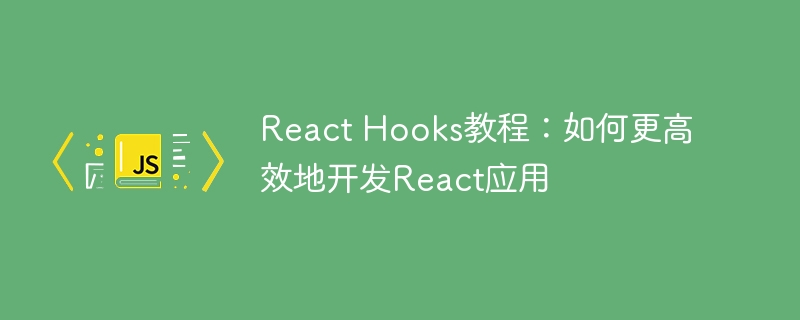Home > Article > Web Front-end > React Hooks Tutorial: How to Develop React Applications More Efficiently

React Hooks Tutorial: How to develop React applications more efficiently
Introduction: React Hooks is a new feature in React 16.8 version, which provides a more concise, A more efficient way to write React components. This tutorial will introduce the basic concepts and usage of React Hooks, and provide specific code examples to help developers better understand and apply React Hooks.
1. What are React Hooks
React Hooks is a way of writing functional components that allows us to use state and other React features without writing classes. By using Hooks, we can more easily share state logic, reuse logic, and separate concerns. The core idea of React Hooks is to "extract state logic from components and use Hooks to reuse these logic codes."
2. Why use React Hooks
3. Basic usage of React Hooks
useState is the most commonly used Hook, which is used to add state in function components .
import React, { useState } from 'react';
function Counter() {
const [count, setCount] = useState(0);
return (
Count: {count}
);
}useEffect is used to perform side effect operations in function components, such as getting data, subscribing to events, etc.
import React, { useState, useEffect } from 'react';
function DataFetcher() {
const [data, setData] = useState(null);
useEffect(() => {
// 获取数据的异步操作
fetchData().then((response) => {
setData(response.data);
});
// 清除副作用的操作
return () => {
cleanup();
};
}, []);
return (
Data: {data}
);
}useContext is used to get the value in the context, avoiding the use of Context.Provider and Context.Consumer.
import React, { useContext } from 'react';
import MyContext from './MyContext';
function MyComponent() {
const value = useContext(MyContext);
return (
Value: {value}
);
}4. Custom Hooks
Custom Hooks is another powerful function of using Hooks. It allows us to abstract out reused logic and realize logic reuse.
import { useState, useEffect } from 'react';
function useWindowDimensions() {
const [width, setWidth] = useState(window.innerWidth);
const [height, setHeight] = useState(window.innerHeight);
useEffect(() => {
const handleResize = () => {
setWidth(window.innerWidth);
setHeight(window.innerHeight);
};
window.addEventListener('resize', handleResize);
return () => {
window.removeEventListener('resize', handleResize);
};
}, []);
return { width, height };
}Use customized useWindowDimensions Hook:
import React from 'react';
import useWindowDimensions from './useWindowDimensions';
function MyComponent() {
const { width, height } = useWindowDimensions();
return (
Width: {width}
Height: {height}
);
}5. Summary
Through the introduction of this tutorial, we understand the basic concepts and main usage of React Hooks, including useState , useEffect and useContext, etc. At the same time, we also learned how to customize Hooks to achieve logic reuse. Using React Hooks can make our React development more efficient and concise, and improve component performance and logic reuse capabilities.
I hope this tutorial can help developers better understand React Hooks and use them flexibly in actual projects. I wish everyone can write more elegant and efficient React applications!
The above is the detailed content of React Hooks Tutorial: How to Develop React Applications More Efficiently. For more information, please follow other related articles on the PHP Chinese website!